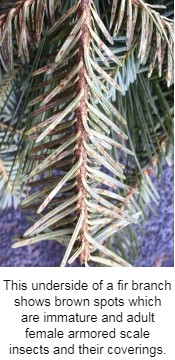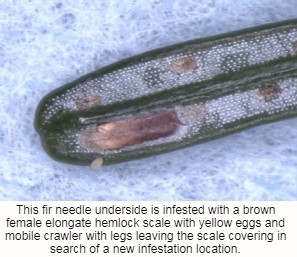 Elongate hemlock scale (Fiorinia externa), or EHS, is an invasive insect pest introduced into the U.S. from Japan around 1908. EHS feeds on a wide variety of conifers besides hemlock (Tsuga), including fir (Abies) and spruce (Picea), although these are the preferred hosts. It damages trees by feeding on the undersides of their needles, sucking nutrients from the undersides of needles, causing them to turn yellow and drop off. Heavy EHS feeding can kill conifers or make them more susceptible to drought and other pests and diseases.
Elongate hemlock scale (Fiorinia externa), or EHS, is an invasive insect pest introduced into the U.S. from Japan around 1908. EHS feeds on a wide variety of conifers besides hemlock (Tsuga), including fir (Abies) and spruce (Picea), although these are the preferred hosts. It damages trees by feeding on the undersides of their needles, sucking nutrients from the undersides of needles, causing them to turn yellow and drop off. Heavy EHS feeding can kill conifers or make them more susceptible to drought and other pests and diseases.
Where EHS Has Been Found
EHS has been detected in Connecticut, Delaware, Georgia, Kentucky, Maine, Maryland, Massachusetts, Michigan, New Hampshire, New Jersey, New York, North Carolina, Ohio, Pennsylvania, Rhode Island, South Carolina, Tennessee, Vermont, Virginia, and West Virginia and the District of Columbia.
EHS in Wisconsin
To date, EHS has never been found in Wisconsin’s forests or Christmas tree fields. However, Department of Agriculture, Trade and Consumer Protection inspectors have found it on cut Fraser and balsam fir Christmas trees and boughs, in wreaths and other evergreen decorations, and on hemlock nursery stock. All these items came from suppliers in states where EHS is well-established, such as North Carolina, Pennsylvania, Tennessee, and Virginia.
 The Risk in Wisconsin
The Risk in Wisconsin
Wisconsin is a major Christmas tree-producing state. Christmas trees are an important product in-state and for export, and choose-and-cut farms are important to the agro-tourism industry. EHS strongly prefers to feed on eastern hemlock, but it also readily feeds on infests fir and spruce, which are among the most valuable Christmas trees. EHS produces one-to-two generations a year, and both immature female nymphs and adult females feed on fluid from needle undersides. While female scales are immobile, crawlers will hatch from scale eggs, and emerge from scale coverings throughout the year to start new infestations, sometimes hitchhiking on squirrels or birds. The insects wrap themselves in a hard, waxy coating, which creates the distinctive “scale” visible on needles. Because of these characteristics, EHS is difficult and expensive to treat with pesticides and systemic products like imidacloprid do not control this pest.
In addition to the threat to Christmas tree fields, EHS also poses a risk to our native hemlock and other balsam fir forests, as well as to ornamental evergreens in parks and yards.
Signs of EHS
-
Yellowing of needles on the interior of the lower branches; damage moves upward as population increases
-
Scale coverings on the underside of the needles
-
Premature needle drop; eventual branch and limb dieback and death of tree with severe infestations
-
Tree may appear flocked
Prevent EHS from Becoming Established in Wisconsin
Consumers
If you buy non-local evergreen wreaths, swags, bough, or arrangements at a chain store for the holidays, dispose of them at the end of the holiday season by burning or bagging them and putting them in your trash. Do not compost them or put them out for collection.
Businesses selling nursery stock and Christmas trees
-
Buy stock grown in Wisconsin or other states where EHS has not been found.
-
Let suppliers know that Wisconsin's EHS quarantine requires all hemlock and fir shipments from infested parts of the Eastern US to either come in with a phytosanitary certificate or be sent to businesses that have a compliance agreement with DATCP requiring stock to be free of this pest.
-
Watch for any sign of EHS and report suspect EHS on trees to DATCP, using contact information on this page.
-
Dispose of known infested material by burning or landfilling.
Quarantine Requirements
<<Return to main pests and diseases page
